Industrial Mixing Tanks: An Overview
Features
Industrial use such tanks are offered in various dimensions and sizes depending on the industry requirements. The following are the conventional parameters:
Capacity
50 to 30000 liters or more, so that it can suit varying production capabilities.
Power
Power varies in the range of 0.75KW – 55KW with the length and complexity of the operations being performed in the tank.
Voltage
Varied voltage levels from 110V to 600V are also provided in the tender, as power systems differ from country to country.
Heating Options
To increase the efficiency of the mixing process, two chief heating methods, depending on the type of application, are provided by these tanks.
Electric Heating
Direct heaters can be fitted on the walls of the tank. This approach is very efficient and straightforward, making it suitable for those tasks that necessitate temperature control extremes.
Steam Heating
Used for bulk processing or where high temperature heat process is required, steam heating is widely used. The standard wrapping of the mixing tank with steam jackets is meant for uniform heat distribution and is used in industries such as food or pharma.
Features of Industrial Mixing Tanks
Industrial mixing tanks are manufactured for effective and enhanced mixing process performance, which is achieved by adjusting the following features:
Customizable Designs
Different tanks can be made to meet your specifications in terms of size, power and voltage.
Durability
Fabricated from quality stainless steel, these tanks have the much-needed attributes of being corrosion, wear and tear resistant, giving them a long life span even in tough industrial conditions.
Efficient Mixing
Four distinct volumetric working ranges and volumetric return pump impellers are applied to all tanks’ mixing pumps. Mixing tanks are designed to minimize settling of products and maintain homogeneity.
Temperature Control
The built-in systems also assist to monitor and control the processes that are temperature sensitive in order to achieve the desired results AOWD.
Versatility
The presence of mixing tanks with many different viscosities gives a possibility for a specific application in different branches.
Safety Features
There are automatic measures for overheating, pressure relief valves and automations, providing safe and dependable operational use.
Agitator Options
One of the major elements of an industrial mixing tank is the agitator. It must be mentioned that the kind of agitator determines the quality of the whole mixing process. Depending on the materials and processes required by the customer, a range of agitators can be made available, such as:
Paddle Agitator
The best type for gentle mixing and low speed mixing. It is used for pastes, creams and gels which are viscous.
Turbine Agitator
Ideal for emulsifying and suspending liquid particles for having high shear mixing.
Anchor Agitator
This type prevents over-engineering, allowing mixing processes to be carried out effectively with high viscous materials, particularly in the food and cosmetic industry.
Propeller Agitator
It is used for low viscous liquids, consumes little power and combines effectively.
Helical Agitator
Effective in the maintenance of medium to high viscosity and gives good axial flow.
Magnetic Agitator
These are suitable for clean-in-place systems where contamination is a factor, particularly in pharmaceutical and biotech industries.
Applications
Used in almost all industrial plants and factories, industrial mixing tanks can also mix and process a variety of material in one package. Some of the common uses include:
Food and Beverage Sector
Mixing operations with liquids, sauces and creams during the production of food; as well as blending liquids, beverages, juices and dairy products.
Pharmaceutical Industry
Preparation of medicines, lotions, ointments that are quite sterile and in controlled conditions.
Cosmetics Industry
Mixing of creams, lotions and emulsions whilst observing the quality of the products produced.
Chemical Industry
Emulsifying various chemicals, resins and solvents during their industrial use.
Paint and Coatings
Pigments and coatings are mixed together to achieve unit dispersion and uniformity of quality.
Frequently Asked Questions
1. I am interested to know what industrial mixing tank can I choose?
Tanks which are suitable for specific use can be obtained in respect to the desired capacity. Small batch production can make use of tanks of around 50 to 1000 liters worth of capacities. In most cases, the rest for industrial use will be large tanks that are around 5000 to 30000 liter in ranges.
2. I want to know whether it is possible to alter the power, voltages I will be using in industrial mixers?
Yes, we can go from 0.75KW to about 55KW in various power settings and customizing voltages are also possible from 110 to 600 watts suitable for various power systems.
3. Industrial mixing tanks, what are they made of?
We usually construct our tanks of stainless steel of a superior grade in order to possess the qualities of corrosion resistance, durability, and easy maintenance.
4. How do I select an agonist for my process?
An agitator selection may be made, guided by the viscosity and the nature of the material to be used. For low viscosity liquids, propeller agitators are most effective, while anchor or helical agitators are effective with high viscosity materials.
5. Could these tanks be deployed for both heating and cooling?
Our industrial mixing tanks can be provided with both heating and cooling systems as per the process guidelines of the client.
Contact Us
Are you looking for an industrial mixing tank that can withstand the rigors of working conditions and suit the production processes? Our specialists can assist you in finding the necessary industrial mixing tank. We surely have ideal mixing tanks for various applications owing to adjustable formats, premium materials, and extensive features. Get in touch with us now for any of our offered items and receive a tailored estimate that meets your production expectations!









